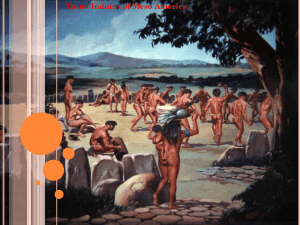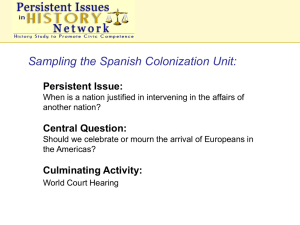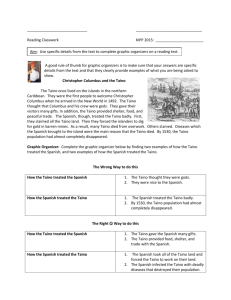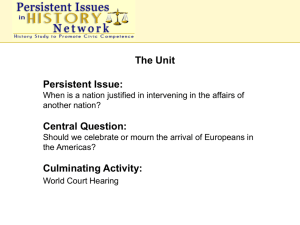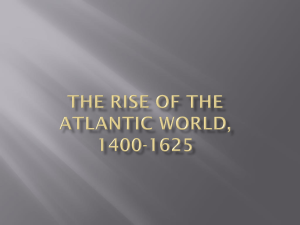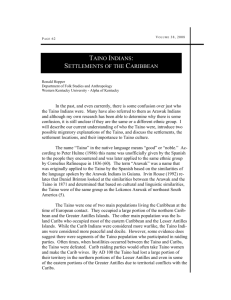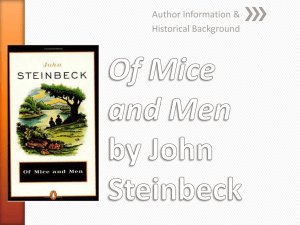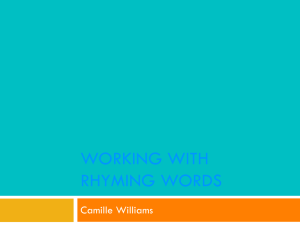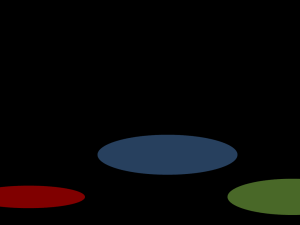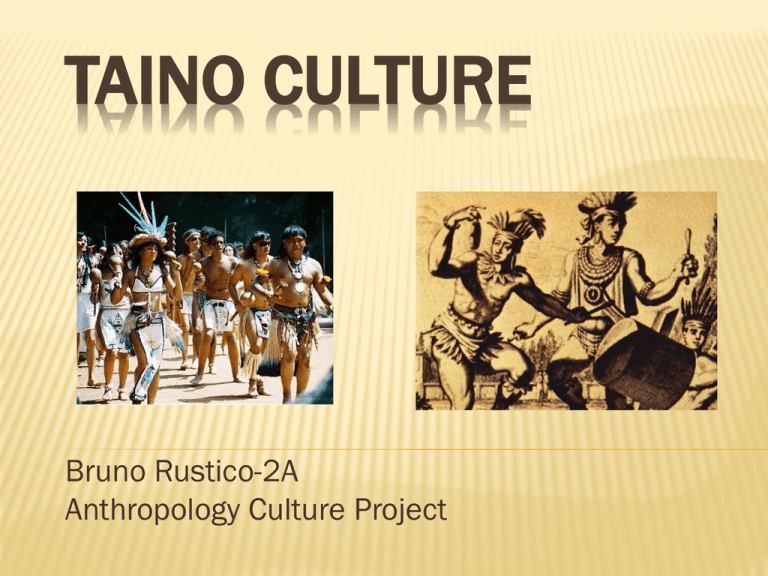
TAINO CULTURE
Bruno Rustico-2A
Anthropology Culture Project
HISTORY OF THE TAINO
Nation of indigenous people who flourished in
the Greater Antilles-Caribbean Sea
Islands include Cuba, Hait, the Dominican
Republic, Jamaica, and Puerto Rico
Taino people dwindled quickly with the arrival
of the Spaniards mainly because the Spanish
brought diseases which were foreign to the
Taino’s immune system
HISTORY OF THE TAINO (CONT.)
Many were enslaved to pave roads, build housing,
farm foods and construct forts
They primarily spoke Arawakan
Originally traveled from the Amazon Basin in the
North Eastern part of South America during the 6th
century
Gentle culture; based on happiness, friendliness,
and a highly organized hierarchical and paternal
society
The word “Taino” means Good and Noble
LOCATION OF THE TAINO
Originally from the North Eastern Part of South
Africa near the Amazon Basin
At the end of the 6th century, they moved to the
Caribbean
Occupying Cuba, Haiti, Puerto Rico, Dominican
Republic, and Jamaica
Although pure Tainos do not exist today,
descendents do and are located mostly on the
eastern board of the U.S.
LOCATION OF THE TAINO
CLIMATE
Average high temperature of the Caribbean is
82oF and low is 74oF.
Average annual rainfall is 39.3 inches
Mountains of Islands will have increased
rainfall (sometimes 200 inches)
Tropical Weather
RESOURCES
Developed agricultural system which was environmentally
friendly and virtually maintenance free
Farmed crop on conuco, a large mound created for farming
They packed the conuco with leaves which improved
drainage and protected it from soil erosion
Primary crops cultivated by the Taino were cassava, yucca,
corn, squash, beans, peppers, sweet potatoes, peanuts, and
tobacco
Used wood from surrounding forests to construct housing, in
addition to mud, palm leaves, and woven straw
Water from streams and fresh water ponds on islands
RESOURCES (HOUSE AND CONUCO)
ECONOMICS
Agricultural Lifestyle
Relied heavily on farming and agriculture
Minor degree of trade; usually all crops and
goods were open for anyone to take
STATUS
When the Spaniards came to the islands, they
brought disease which were detrimental to the
Taino as their immune system was unable to
handle the diseases
Taino were made “slaves” for Spaniards
Both combined ultimately caused extinction.
No pure Taino exist today, however mixed
descendents do exist today and are mainly
located on the east coast of the U.S.
MIGRATION OF CULTURE
The Taino are a branch off the Arawak culture
Taino mainly stood by themselves with no major
migration of culture
GOVERNMENT
Highly organized hierarchical society-top leader is the Chief
Paternal Society
Importance in the tribe being determined by the size of the
clan, rather than its war-making strength. There was no
aristocracy of lineage, nor were their titles other than those
given to individuals to distinguish their services to the clan.
Divided into three social classes:
Naborias (working class)
Nitaínos or sub-chiefs
Noblemen (priests/medicine men)
RELATIONSHIPS OF THE TAINO
Close internal relationship-always friendly
towards neighbors and fellow tribe members
Little to no relations outside the
tribe/community…only relations would be with
Spaniards
CULTURE
Developed in the late 1400s-early 1500s, with the
sole founder, Juan Ponce de León (he took
possession of the land)
Twenty villages were established (20,000-50,000)
Dwindled down to 4, 000 due to disease, war, and
maltreatment
Cacique Agüeybana was the original Chief
Rank was established along democratic lines
People of the island would gradually join,
increasing the size of the tribe
CONTRIBUTIONS
Had little to no contact with the outside world
Created agriculture and travel/transportations
needs (canoes, rafts etc.)
When Spaniards invaded, became slave
workers for them
RELIGION/BELIEF SYSTEM
Ceremonial ball parks whose boundaries were
marked by upright stone dolmens
Dances were created for spirits
Strongly believed in cosmology as main source of
religion-based beliefs off of stars and alignment
Yocahu was the supreme Creator
Jurakán, power of hurricanes
Zemi and Maboya, sex icons/marriage/love
Being in “good graces” of the above officials meant
they were protected against disease, war, and
hurricanes.
MUSIC
Highly relied on dance to communicate with the supernatural/spirits
Taíno used music to recall and to recount their history,
for celebrations and special events, and to
communicate with their spiritual guides, their zemís to
cure illnesses, for protection against them and endeavor
storms from Mother Nature.
Tainos also used their music to have rain when they
needed good crops, to hunt, and to fish
No specific details on type of music; suggested that one
leader led the group and others sang in the background
MUSIC (CONT.)
Dance
Cave Drawings by Taino of music
LITERATURE
Cave drawings
No books or bindings of literature
Only used pictures; no words
ART
Cave drawings (animals/music/working)
Sculptures of super-natural
Engraving of stones
CLOTHING
Men generally went naked or wore a breech
cloth, called nagua
Single women walked around naked
Married women wore an apron over their
genitals
Usually made out of cotton and palm fibers
Both sexes painted themselves on special
occasions; they wore earrings, nose rings, and
necklaces
CLOTHING (CONT.)
CUSTOMS
Polygamy was practiced
Often married within the same clan or family
Dead were buried with a proper ceremonial
(dance)
For holidays and celebrations, they danced and
socialized with everybody
Not many records of customs
CUISINE
Staples included vegetables, fruit, meat, and fish
No large animals on islands
Earthworms, lizards, turtles, birds, and other mammals were
eaten.
Crops farmed on conucos (farming mound)
EDUCATION
No formal system of educated; offspring
learned how to farm from elders
Language and carvings/religion was passed
down to offspring
TECHNOLOGY
Taino used cotton and palm for fishing nets and
ropes
Constructed canoes( can usually hold 15-20
people) (larger one could carry up to 200
people)
Agriculture/Irrigation (minor)
WORKS CITED
Photograph. Web. 4 June 2012. <http://talking-feather.com/wpcontent/uploads/2011/08/Taino-Cutlture-1.jpg>.
Photograph. Web. 4 June 2012. <http://kreyolicious.com/wpcontent/uploads/2012/05/tainos.jpg>.
Taino History & Culture - Cultura Taina Y Historia." Taino History & Culture Cultura Taina Y Historia. Web. 04 June 2012.
<http://www.tainoage.com/tainoh.html>.
Photograph. Web. 4 June 2012.
<http://www.powhatanmuseum.com/sitebuilder/images/Caribbean_Map757x554.jpg>.
Caribbean Clime Taino. Web. 4 June 2012. <http://www.geographysite.co.uk/pages/countries/climate/caribbean_climate.html>.
WORKS CITED (CONT.)
Rainfall Caribbean." Web. 4 June 2012.
<http://www.currentresults.com/Weather/Caribbean/average-annualtemperature-rainfall.php>.
Photograph. Web. 4 June 2012.
<http://farm3.static.flickr.com/2254/2198381912_e82ed16e38.jpg>.
Photograph. Web. 4 June 2012.
<http://pr.kalipedia.com/kalipediamedia/historia/media/200808/01/hisp
uertorico/20080801klphishpr_12_Ies_SCO.jpg>.
Caribbeanedu.com | Caribbean Odyssey." Caribbeanedu.com | Caribbean
Odyssey. Web. 04 June 2012.
<http://www.caribbeanedu.com/odyssey/timeliner/arawaks.asp>.
Taino Music Musica Taina De Los Tainos De Puerto Rico." Taino Music
Musica Taina De Los Tainos De Puerto Rico. Web. 04 June 2012.
<http://www.tainoage.com/taino_music.html>.
WORKS CITED (CONT.)
Photograph. Web. 4 June 2012.
<http://conciliotainopr.org/pics/ConcilioTaino.DSC00422.JPG>.
Photograph. Web. 4 June 2012.
<http://images.fineartamerica.com/images-medium-large/taino-musiciansdance--prehistoric-caribbean-taino-indians-cave-painting-ramon-a-chalassoto.jpg>.
Photograph. Web. 4 June 2012.
<http://www.google.com/imgres?num=10&um=1&hl=en&client=firefoxa&rls=org.mozilla:enUS:official&biw=1366&bih=664&tbm=isch&tbnid=5sGlmCQHMR5XQM:&i
mgrefurl=http://www.centrelink.org/Dec2002.html&docid=gwbxpyzeF7NIz
M&imgurl=http://www.centrelink.org/fig15suspicious.jpg&w=284&h=261&
ei=wEjNT9OoMs6N6QHP7fTcAg&zoom=1&iact=rc&dur=215&sig=1064371
33603681451547&page=1&tbnh=147&tbnw=174&start=0&ndsp=18&ve
d=1t:429,r:3,s:0,i:78&tx=32&ty=88>.
WORKS CITED (CONT.)
Web. 4 June 2012. <http://www.tripadvisor.com/LocationPhotos-g147288d1724307-Paraiso_Cano_Hondo-Dominican_Republic.html>.

